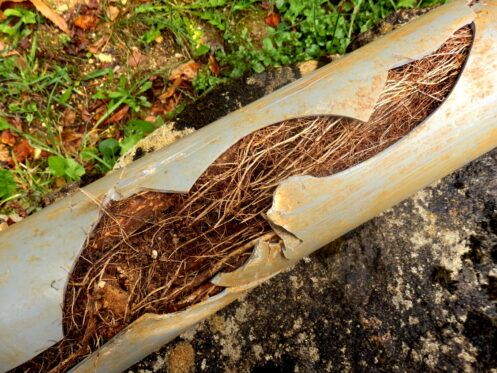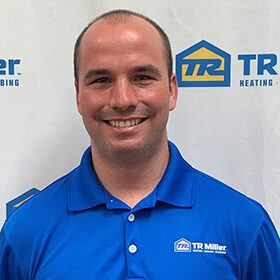Tree roots and plumbing systems often find themselves at odds. As roots naturally seek out water and nutrients, they can intrude into underground pipes, leading to a myriad of issues. Understanding these potential problems can aid in prevention, ensuring a smooth-running plumbing system and avoiding costly repairs.
1. Pipe Blockages
Tree roots have an uncanny ability to detect moisture sources in the soil, which often leads them to our underground plumbing systems. These determined roots can infiltrate even the tiniest openings in our pipes in search of water. Once inside, they’ll expand and proliferate, causing significant obstructions. The result is a substantial barrier within the pipes. This not only diminishes the flow of water but also accumulates other debris, exacerbating the blockage. When severe, you might find your daily routine hampered due to reduced drainage efficiency and unpleasant plumbing backups.
2. Pipe Cracks
The force with which tree roots grow should not be underestimated. Tree roots can slowly but firmly exert pressure on any obstacle in their path, including our underground pipes. As these roots envelop or press against a pipe over time, they can inflict damage in the form of cracks or fractures. What starts as a minor breach can evolve into a significant problem. Water begins to escape from these fractures, saturating the surrounding soil. You may face the dual challenge of increased water bills and the potential costs of repairing damage to your property or landscape.
3. Misalignment of Pipes
As roots snake their way around pipes, they can cause them to shift or even lift, leading to misalignments. These dislodged pipes disrupt the efficient flow of water, making the system more vulnerable. Misaligned pipes don’t just impede water flow; they also become more susceptible to damage. The altered position may expose them to external pressures or cause sections to sag, both of which can result in future breaks or leaks.
4. Sewer System Interruptions
Among the many problems caused by tree roots, the invasion of sewer lines is of particular concern. Homes can experience distressing sewage backups when roots obstruct the smooth flow of wastewater away from the property. Sewage backups are more than just an inconvenience. When sewage is backed up, it introduces a pungent odor into your home. More alarmingly, backups can also expose households to harmful bacteria and pathogens. Such an intrusion can compromise the health of inhabitants, emphasizing the importance of regularly inspecting and maintaining sewer lines.
5. Impeded Water Pressure
Over time, interference from tree roots results in a notable decrease in water pressure. Whether taking a shower or washing dishes, you will experience reduced efficiency from water fixtures. This compromised water pressure not only affects the convenience of daily routines but might also raise concerns about water cleanliness, since contaminants can get into the water supply with weakened water flow.
6. Trapped Accumulations
Nature is complex, and the ways tree roots interact with human-made structures show this well. When tree roots infiltrate plumbing systems, they can weave together, creating intricate mesh-like barriers inside the pipes. These natural “nets” are incredibly effective at trapping debris, including common waste like grease, hair strands, and residue from soaps and detergents. As these substances get caught, they begin to accumulate, leading to significant blockages. Not only does this disrupt the usual flow of wastewater, but it also necessitates frequent and sometimes costly pipe cleanings. In extreme cases, such accumulations can lead to significant obstructions that impede the function of the entire plumbing system.
7. Gas and Odor Emissions From the Sewer Line
A common and rather distressing issue you might face due to tree root intrusion in sewer lines is the emission of unpleasant odors. As these roots create blockages, either partially or wholly, they inadvertently lead to the buildup of sewage gases, primarily methane. This gas, known for its distinct and foul smell, can seep out from compromised parts of the sewer line, pervading the surrounding area. While the odor is a source of discomfort and embarrassment for many, the more pressing concern is the potential health risks. Accumulated methane that infiltrates living spaces can pose hazards, especially in large concentrations. It’s imperative to address such issues promptly to maintain a safe and pleasant living environment.
8. Increased Repair Costs
It’s universally accepted that the best way to deal with a problem is to prevent it. Because tree roots are a formidable foe to plumbing systems, a small oversight in maintenance can escalate into a major issue. As these roots infiltrate plumbing lines, they can cause damage that isn’t just superficial. The repercussions can range from needing to replace significant portions of piping to overhauling the entire system. This kind of extensive repair work doesn’t come cheap. You may find yourself facing substantial bills. The cost of routine maintenance pales in comparison to the potential expenses incurred from root-induced damage.
9. Contaminated Water Supply
The safety and purity of our water supply are paramount. However, when tree roots intrude into our plumbing systems, they bring with them a host of unwelcome guests. As these roots make their way into pipes, they can carry soil, silt, and other contaminants. Over time, this foreign matter can mix with the water that flows from our taps. While it may seem like a minor inconvenience, consuming or using this contaminated water can be harmful. It poses a real health risk, especially if harmful microbes or chemicals are present. It’s imperative to ensure that our water remains untainted and safe.
10. Decreased Lifespan of Plumbing System
A home’s plumbing system is akin to its circulatory system, vital and expected to last. However, like any system, it has a projected lifespan. Frequent encounters with tree roots can drastically shorten this. The persistent pressure and strain these roots place on pipes can cause wear and tear faster than anticipated. Over time, this consistent assault weakens the integrity of the entire system. Before you realize it, you might be facing the daunting task of replacing parts, or worse, your entire plumbing system earlier than expected. This not only disrupts daily life but also demands considerable financial outlay.
11. Septic System Malfunctions
Septic systems are crucial for homes that aren’t connected to public sewer lines. They’re responsible for treating wastewater locally. However, they’re not immune to the relentless advance of tree roots. These roots, in their quest for moisture and nutrients, can penetrate the septic tank or the drainage field. Such intrusions can seriously hamper the system’s ability to effectively process waste. The result are backups, overflows, and a system that’s not operating optimally. In the worst-case scenario, the septic system can fail, necessitating costly repairs or replacements, and potentially causing environmental contamination.
Contact Us Today!
At TR Miller Heating, Cooling & Plumbing in Plainfield, Illinois, we provide a whole host of comprehensive plumbing services that include drain cleaning, toilet repairs, and water heater installation and repair. We also specialize in home comfort, as we provide heating, cooling, and indoor air quality solutions. Contact TR Miller Heating, Cooling & Plumbing for an inspection of your plumbing system today.


